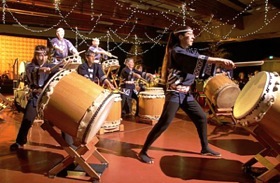
In 1942, in one of the low points in American history, the government issued an order for the relocation and internment of Japanese and Japanese-Americans, citizens and noncitizens alike. Well over 100,000 people, living mainly in California, Oregon, and Washington, had their lives completely uprooted. An official apology was not issued until 1988.
In Japan as well, more and more citizens had their lives drastically changed by circumstances out of their control as the war continued. One of them was a 14-year-old army conscript who in 1944 secretly began listening to Western music, which was then outlawed. Toru Takemitsu equated traditional Japanese music with the bitterness of his personal situation and found comfort in the classical music of the West, especially the compositions of Claude Debussy. Two years later, he began to compose his own works. Takemitsu, who was largely self-taught, is known for his wide range of compositions, including film scores, and he remained an international musical force until his death in 1996. Today, he is considered the preeminent 20th-century Japanese composer of classical music.
The Feb. 20 performance combines music with historical photographs and artifacts, a documentary film, and talks by local historian and journalist Gaye LeBaron and by Marie Sugiyama, a local resident who was confined at the Amache internment camp in Colorado. In their turn, the Santa Rosa Chamber Players will perform Takemitsu’s Quatrain II and Joji Yuasa’s Solitude in Memoriam T.T. Takemitsu’s piece was originally written for a chamber group plus symphony; this is a reworking, done for a quartet alone. It’s an homage to Olivier Messiaen, another strong influence on his work, but also reflects his personal reconciliation with traditional Japanese cultural influences. As with much of his work, the piece is inspired by nature. It also is based on the emaki style of scroll painting in which each scene is independent but still linked to other scenes on the scroll.
Yuasa is another contemporary classical composer from Japan, a colleague of Takemitsu’s who participated in the Experimental Workshop movement in Japan that the latter composer helped found. Like his colleague, Yuasa was influenced by Western composers, though he is also known for incorporating traditional Japanese music, Noh drama, and Zen Buddhism into his work. His elegiac Solitude in Memoriam T.T. was commissioned for a memorial concert several months after Takemitsu’s death.
Rounding out the musical portion of the festival is a performance by Sonoma County Taiko. If this will be your first exposure to these powerful performances combining percussion, martial arts, and dance, expect an exciting performance with an obviously strong rhythm and a surprising melodic component — melodic enough that Canadian champion figure skater Elvis Stojko used a taiko composition as the music for one of his 1998 Olympic programs. This Japanese art form began to gain popularity in the U.S. in the 1960s, with the first modern taiko group in the country established in San Francisco in 1968. It’s a fitting addition to a program designed to increase cultural and historical understanding.

